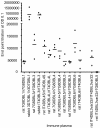Induction of strain-transcendent antibodies to placental-type isolates with VAR2CSA DBL3 or DBL5 recombinant proteins
- PMID: 21314945
- PMCID: PMC3055221
- DOI: 10.1186/1475-2875-10-36
Induction of strain-transcendent antibodies to placental-type isolates with VAR2CSA DBL3 or DBL5 recombinant proteins
Abstract
Background: Pregnancy associated malaria is a severe clinical syndrome associated with sequestration of Plasmodium falciparum-infected erythrocytes in the placenta. Placental binding is mediated by VAR2CSA, which adheres to chondroitin sulphate A (CSA). VAR2CSA is a large and polymorphic protein that has six Duffy binding-like (DBL) domains. There is still limited understanding as to how effective individual VAR2CSA domains are at generating inhibitory antibodies or the number of domain variants needed for universal vaccine coverage.
Methods: To investigate the immunogenic properties of single domain VAR2CSA recombinant proteins, rats or rabbits were immunized with five of the six VAR2CSA domains produced in Pichia pastoris. Immune plasma was analysed against a geographically diverse panel of CSA-binding lab lines to assess antibody breadth and inhibitory activity.
Results: Of the five domains, DBL3, and to a lesser extent DBL5, induced antibodies that cross-reacted on five diverse CSA-binding parasite lines by flow cytometry. By comparison, anti-DBL6 antibodies were highly strain-specific and anti-DBL1 and anti-DBL4 antibodies were poorly reactive by flow cytometry. From this series of recombinant proteins, adhesion-blocking activity was restricted to a single rat immunized against a DBL4 recombinant protein.
Conclusions: Single domain VAR2CSA recombinant proteins produced in P. pastoris had limited efficacy in eliciting adhesion blocking antibody responses, but VAR2CSA DBL3 and DBL5 domains contain strain-transcendent epitopes that can be targeted by vaccination and may have application for vaccine development.
Figures





Similar articles
-
Evidence for globally shared, cross-reacting polymorphic epitopes in the pregnancy-associated malaria vaccine candidate VAR2CSA.Infect Immun. 2008 Apr;76(4):1791-800. doi: 10.1128/IAI.01470-07. Epub 2008 Feb 4. Infect Immun. 2008. PMID: 18250177 Free PMC article.
-
Var2CSA DBL6-epsilon domain expressed in HEK293 induces limited cross-reactive and blocking antibodies to CSA binding parasites.Malar J. 2008 Sep 4;7:170. doi: 10.1186/1475-2875-7-170. Malar J. 2008. PMID: 18771584 Free PMC article.
-
Immunization with VAR2CSA-DBL5 recombinant protein elicits broadly cross-reactive antibodies to placental Plasmodium falciparum-infected erythrocytes.Infect Immun. 2010 May;78(5):2248-56. doi: 10.1128/IAI.00410-09. Epub 2010 Mar 1. Infect Immun. 2010. PMID: 20194590 Free PMC article.
-
Designing a VAR2CSA-based vaccine to prevent placental malaria.Vaccine. 2015 Dec 22;33(52):7483-8. doi: 10.1016/j.vaccine.2015.10.011. Epub 2015 Nov 26. Vaccine. 2015. PMID: 26469717 Free PMC article. Review.
-
Cytoadhesion of Plasmodium falciparum-infected erythrocytes and the infected placenta: a two-way pathway.Braz J Med Biol Res. 2006 Dec;39(12):1525-36. doi: 10.1590/s0100-879x2006001200003. Braz J Med Biol Res. 2006. PMID: 17160261 Review.
Cited by
-
Immunogenicity of the Plasmodium falciparum PfEMP1-VarO Adhesin: Induction of Surface-Reactive and Rosette-Disrupting Antibodies to VarO Infected Erythrocytes.PLoS One. 2015 Jul 29;10(7):e0134292. doi: 10.1371/journal.pone.0134292. eCollection 2015. PLoS One. 2015. PMID: 26222304 Free PMC article.
-
Antibody mediated activation of natural killer cells in malaria exposed pregnant women.Sci Rep. 2021 Feb 18;11(1):4130. doi: 10.1038/s41598-021-83093-4. Sci Rep. 2021. PMID: 33602987 Free PMC article.
-
VAR2CSA signatures of high Plasmodium falciparum parasitemia in the placenta.PLoS One. 2013 Jul 25;8(7):e69753. doi: 10.1371/journal.pone.0069753. Print 2013. PLoS One. 2013. PMID: 23936092 Free PMC article.
-
Multilaboratory approach to preclinical evaluation of vaccine immunogens for placental malaria.Infect Immun. 2013 Feb;81(2):487-95. doi: 10.1128/IAI.01106-12. Epub 2012 Dec 3. Infect Immun. 2013. PMID: 23208604 Free PMC article.
-
Transcriptome Analysis of Plasmodium falciparum Isolates From Benin Reveals Specific Gene Expression Associated With Cerebral Malaria.J Infect Dis. 2022 Jun 15;225(12):2187-2196. doi: 10.1093/infdis/jiac086. J Infect Dis. 2022. PMID: 35255125 Free PMC article.
References
-
- Steketee RW, Nahlen BL, Parise ME, Menendez C. The burden of malaria in pregnancy in malaria-endemic areas. Am J Trop Med Hyg. 2001;64:28–35. - PubMed
-
- Buffet PA, Gamain B, Scheidig C, Baruch D, Smith JD, Hernandez-Rivas R, Pouvelle B, Oishi S, Fujii N, Fusai T, Parzy D, Miller LH, Gysin J, Scherf A. Plasmodium falciparum domain mediating adhesion to chondroitin sulfate A: a receptor for human placental infection. Proc Natl Acad Sci USA. 1999;96:12743–8. doi: 10.1073/pnas.96.22.12743. - DOI - PMC - PubMed
Publication types
MeSH terms
Substances
LinkOut - more resources
Full Text Sources
Miscellaneous

